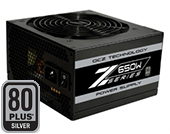In our last Green Computing Review, we looked the 80 Plus Bronze PSU from Antec, the EA-430D Green. We built that power supply into our home theater PC. This time around, we need something with a little more kick to power our gaming machine.
In addition to our Core i7 860, 4GB of G.Skill ECO RAM, X-Fi, Blu-ray, and hard disks, we needed to make sure we had enough power for our GTX 470
. Nvidia states that the minimum power supply for the GTX 470 should put out 550 watts. There are plenty of PSUs out there that offer more power than that, even efficient ones.
We want to provide enough power to both push our gaming machine and allow more components later on, but not overdo it. Enter the OCZZ650 80 Plus Silver PSU. We decided on this 650 watt gem. This was our first power supply from OCZ. Historically, it’s always been Antec or Corsair.
Since the idea of green computing is starting to catch on, the no name brands are looking like a worse idea every day to PC builders. Today their is a large selection of 80 Plus power supplies available from many respectable brands.
OCZ Z650 At A Glance

| Model | OCZZ650 | Type | 650 Watt ATX12V 2.2 EPS12V 2.91 |
| PFC | Active | Fans | 120mm thermally controlled |
| 12V Rails | 4 | SLI | ATX12V 2.2 EPS12V 2.91 |
| Main Connector | 24 pin | GPU Connectors | 6 pin, 6+2 pin |
| Molex Connectors | 5 | SATA Connectors | 4 |
| Efficiency | 80 Plus Silver: over 85% at any load between 20% and 100% | ||
Strong Points
The selling point on a PSU like this is obviously its efficiency. For every step up you go in 80 Plus certification, you can expect to pay more. However, you make up this difference easily during the life of the power supply. Silver is a great level to buy at since the step up to Gold certification is still somewhat cost prohibitive.
This PSU meets my two most important criteria beyond its efficiency: noise and temperature thresholds. The Z650 features a thermally controlled 120mm fan, which I have never been able to hear. That must be because it never gets hot enough to spin up. Even under extended periods of load, this power supply is quiet and cool.
The assortment of connectors available on the PSU makes it very versatile. It comes with an extra strap to tie off any branches you might not need (it’s not modular).
Drawbacks
The ‘P4’ or mainboard connector on this PSU was about an inch too short to connect to the ASUS P7P55DE Pro in my HAF 922 by Cooler Master
case unless I went straight up in front (in the way of the PCI slots). In its defense, ASUS put the connection at the top of the mainboard. I had a P4 extension lying around that allowed me to run it back behind the mainboard.
As you can see in the detailed picture, this PSU is not modular. This is not necessarily a drawback. More breaks in a solid line are more chances for problems. I prefer the solid wiring right from the source.
PCI Express Connectors
The Z650 supports many GPU applications with its 2 sets of PCI Express connectors. It includes a 6 pin and a 6+2 pin setup. A PCI Express card that doesn’t use any extra power cord is referred to as a ’75W’ card, because 75 watts is the limit the card can pull from the PCI Express slot. The 6 pin cables offer an additional 75 watts apiece to cards that need it. The 8 pin connector simply uses 2 extra ground wires.
| Single 6 pin, also known as ‘150W’ cards | Example | Nvidia GTS 250 |
| Dual 6 pin, also known as ‘225W’ cards | Example | Nvidia GTX 260 or GTX 470 |
| Single 6 pin + Single 8 pin, also known as ‘300W’ cards | Example | Nvidia GTX 280 |
The Bottom Line
Separating the wheat from the chaff has become easier when sifting through a sea of power supplies available today. Having the 80 Plus Silver certification alone can pretty much guarantee that you are getting a top quality product. Having such high efficiency means a lot less heat. Less heat means less fan speed. Less fan speed means less noise. All these benefits and less power consumption, too.
If you plan on running SLI or Crossfire, then you’ll want to go with more wattage for most applications. Otherwise, the OCZ Z650 is a great unit for any gaming machine running a single graphics card. Just remember to pick up a 4 pin extension cable if your motherboard has the connector near the top.











